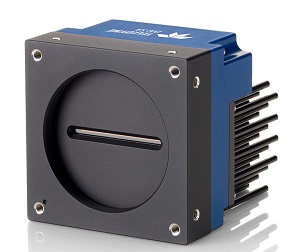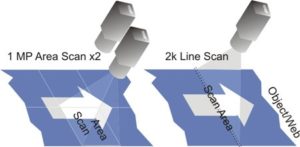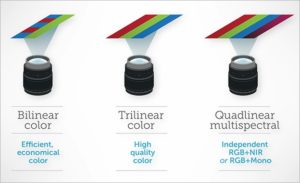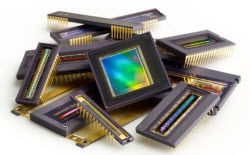

Perhaps the most common example of line scan camera imaging is the fax machine. Line scan camera imaging uses a single line of sensor pixels (effectively one-dimensional) to build up a two-dimensional image. The second dimension results from the motion of the object being imaged. Two-dimensional images are acquired line by line by successive single-line scans while the object moves (perpendicularly) past the line of pixels in the image sensor.
For a given field of view, one 2k line scan camera cost-effectively provides the same resolution as two mega-pixel area scan cameras, without image smear or the redundant processing of frame overlaps.

Advantages
Line scan camera image capture has many benefits, including:
The tradeoffs in line scan camera imaging usually relate to lighting and optics. Illumination must remain reasonably uniform over the entire field of view, although the in-camera flat-field correction available on almost all of our cameras can compensate for poor uniformity. Integration times in line scan camera imaging are typically very short, so illumination intensity generally needs to be high–again, Teledyne DALSA’s high sensitivity TDI line scan products, with 100x greater sensitivity than most comparable linescan, address this problem. Optical demands center around the typically large image circle diameter required for line scan imagers because of their high resolution, and the minor aberrations inherent in spherical optics.
Machine vision cameras have tended to be monochrome, especially in line scan camera. But color gives information and insight that you just can’t get from shades of gray. So where do you find powerful, affordable, easy to use color line scan options?
Teledyne DALSA offers a range of color line scan cameras and line scan sensors to serve applications from the most price-conscious to the most performance-hungry. From clever bilinear to benchmark trilinear to innovative quadlinear products that extend into the multispectral range, our latest CMOS line scan cameras give you the power and performance to conquer color imaging applications such as recycling, postal and parcel sorting, transportation, food and web inspection.


Machine vision performance requirements always increase. Over the last decade, feature sizes in applications such as semiconductor wafer inspection have shrunk by a factor of 3.3 in each dimension (~10.8x overall), while wafer areas have grown by a factor of 2.25 (from 200 mm to 300 mm lines) even though wafer throughputs in wafers per hour have remained the same. Measured as the product of speed and resolution, performance has increased by roughly a factor of 25. Nowhere are these demands stronger than in linescan imaging, where integration times are mere microseconds and budget and safety concerns limit the available light.
Note: Main contents are taken from our principals M/s Teledyne Dalsa
We'll be glad to help you! Please contact our Sales Team for more information.
We'll be glad to help you! Please contact our Sales Team for more information.